By Emily K. Alhadeff , Associate Editor, JTNews
Rachel Smith-Mosel’s ketubah, or Jewish marriage contract, features two intertwining trees. “I think that’s what a marriage is,” she explains. “Deep roots, strong and tall as a tree.”
But Smith-Mosel is not technically married, even though she and her partner, Sandy Mosel, have had three weddings and have four children.
“I get to carry a little plastic card that says I’m a domestic partner,” she laments. “It’s really ridiculous.”
Smith-Mosel’s ketubah is one of 13 same-sex ketubot (plural of ketubah) on display for one night at the Linda Hodges Gallery on October 4.
“Equal Vows: Same-Sex Ketubot in Washington State” is the only known exhibition of same-sex ketubot. Organized by the Jewish Marriage Equality Coalition — 25 organizations and synagogues working to legalize same-sex marriage in Washington State — the event aims to raise awareness leading up to the Referendum 74 vote this November. If approved, same-sex marriage will be legalized.
“We had planned a march in Olympia on February 16,” says David Jacobson, organizer and curator of the event. “It occurred to me, What could we do to make Jewish members of this march stand out? It struck me that ketubot are really a visual statement of what same sex couples mean to each other.”
The march never happened (Gov. Chris Gregoire signed the marriage equality bill into law Feb. 13), but, says Jacobson, “It became apparent that there would be a referendum contesting the law, at which point we decided, What if we had an exhibit of these ketubot, since we didn’t have a place to march anymore?”
In addition to the same-sex ketubot, the exhibit will hold three opposite-sex ketubot, including that of Washington State Rep. Reuven Carlyle (D-36th). The gallery will also feature the couples’ stories with photos, a slideshow and descriptive panels. “It’s not only the artwork that speaks, but the whole story,” says Jacobson.
Although the first Jewish marriage contract dates back to the 5th century BCE, the ketubah emerged in the first centuries of the Common Era to protect women in their marriages and ensure that husbands provided food, clothing, sexual relations and money in the event of divorce.
Around the 16th century, Jews of Sephardic and Oriental lands began decorating their ketubot. According to Sharon Liberman-Mintz, curator of Jewish art at the Jewish Theological Seminary in New York, decorated ketubot flourished “probably because the text was so stratified.” It was a way to make a staid legal document personal. But by the 19th century, decorated ketubot had diminished in popularity.
Then came the 1970s.
“In the ‘70s there was a whole back-to-the-earth movement,” says Liberman-Mintz. “The Jewish Catalog” came out, and “it was very crunchy, touchy-feely,” she says. “There was this reinterest in personalizing and making it your own.”
In the days since, myriad alternative ketubah texts — from egalitarian to interfaith — have emerged.
“It’s a commitment document,” says Liberman-Mintz. “The spirit is the same even if the text isn’t.” She also points out that the word ketubah translates to “that which is written.” That potentially leaves a lot of room for interpretation.
“The tradition of Judaism has found a way to show the commitment of people in these relationships, which were obviously not enshrined in the Bible as originally written, but there has been enough flexibility in the tradition and room to make these relationships special and enriched by our long history,” says Jacobson. “I think that’s really beautiful.”
“The people that have a custom-made ketubah, sometimes they tell me [it is] the most important thing in the preparation of their marriage,” says Gina Jonas, a local calligrapher who designed a ketubah for Gretchen Todd and Julie Tarday. “It’s a living process. It’s a creative process.”
For Todd and Tarday, she says, “When we came to the signature block…they would put “˜bride and bride.’ They got so excited that they could write that. That’s what I remember being very fun for them.”
“Equal Vows” is a “creative and beautiful way to promote the idea that marriage is marriage,” says Marcia Ventura, whose ketubah will be on display. She and her partner, Wendy Hueners, view their ketubah as their wedding certificate.
But, like Rachel Smith-Mosel, Hueners sees her love story as bittersweet. Since Ventura is the biological mother of their son, “I have to go through the process of adopting him,” she says. “It’s expensive and it’s time consuming and it’s ridiculous.”
Smith-Mosel and Sandy Mosel have fought for same-sex rights, and last year Mosel and their son testified before the state legislature. In addition to a Canadian wedding, the couple married in California before Proposition 8 was overturned.
“We’re kind of in this weird limbo,” says Smith-Mosel. “The minute you get to Washington it’s as good as toilet paper.”
Their ketubah incorporates their children’s names, as well as a meaningful line: “I saw her, she smiled, and I knew.” Smith-Mosel says she has the image tattooed on her arm.
“It’s my marriage,” she says. “You’re going to have to take my arm off to take it away from me again.”
